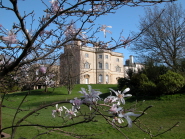The University of Bristol is inviting people to delve into the rich history of two hidden gems - Goldney Garden and Royal Fort Garden – through tours taking place between May and September.
Royal Fort Gardens, which is nestled away behind Tyndall Avenue, began life as a Civil War fortification created to defend the city in the 16th century. Although it’s open to the public, few people are aware of its pivotal role in Bristol’s history.
Goldney Garden is home to one of the country’s best-preserved grotto, which was created by wealthy merchant Thomas Goldney in the 17th century as an elaborate town garden. It’s currently a hall of residence, located at the top of Constitution Hill, and is normally closed to the public.
Alan Stealey, External Estates Manager at the University of Bristol, said: “The University maintains a large number of listed buildings and gardens which are a significant part of Bristol's heritage.
“Whilst the student experience remains our priority, we welcome the opportunity to invite members of the public into these two beautiful spaces and to enthral them with tales of the past and present.”
Knowledgeable and professional guides will be on hand to uncover the gardens’ past on various dates between May and September.
Tours cost £5.50 and must be booked in advance by contacting Nicolette Smith – nicolette.smith@bristol.ac.uk
About Royal Fort Garden
The landscape around the Royal Fort has altered dramatically over the past four centuries and little remains of the fortifications created to defend the city during the Civil War (1642–46).
It was originally known as Windmill Fort, located at the top of St Michael’s Hill, before the Royalists captured Bristol and Dutch military engineer Sir Bernard de Gomme redesigned it.
It was the strongest defence in Bristol and acted as the Western headquarters for the Royalist army under Prince Rupert of Rhine, the 23-year-old commander of the Royalist cavalry.
Prince Rupert surrendered to Oliver Cromwell and Lord Fairfax in 1645, with the fort being demolished in 1655.
The wealthy Tyndall family, who established Bristol’s first bank, acquired the land to build a sizeable new house with generous gardens.
The current three-storey villa was built between 1758 and 62 for Thomas Tyndall, a wealthy Bristol merchant, and his young wife Alicia. Its three facades in three different classical styles - Baroque, Palladian and Rococo - were a compromise after three separate architects submitted designs.
A later Tyndall generation called in the landscape designer, Humphry Repton, to screen their ‘pleasure grounds’ from urban sprawl after a disastrous housing scheme fell through. Repton's original drive and planting around the house have recently been reinstated.
The Tyndall family lived there until 1916, when the house and grounds were bought by Henry Herbert Wills, who later donated it to the University of Bristol.
About Goldney Garden
The ornate garden hidden away behind Goldney House, in Clifton Wood, includes a heritage orchard, an ornamental garden, an orangery, a canal and tower, a rotunda and bastion, Corinthian columns and the elaborate grotto which is one of the finest surviving examples of an 18th century garden grotto in Britain.
The Goldney family first came to live on the property in 1694, when Thomas Goldney II rented it. He later bought the property in 1705 before rebuilding the house and adding to the garden in the 1720s.
However, most of what we see today was the work of his son Thomas Goldney III who enlarged the garden to 16 acres in over 35 years.
He kept a garden book which logged all the work he carried out to transform the grounds. His first major project in 1737 was the construction of the Grotto.
The first part of this scheme was actually to build a tunnel, so that he would not have to cross the public footpath leading through his estate.
The Grotto itself was completed 27 years later in 1764. The walls and pillars are covered with a vast variety of minerals, shells, corals, rocks and fossils, some of which may have been brought back to Bristol by Captain Woodes Rogers.
In 1760, the Orangery was constructed to house an exotic collection of citrus trees which would have been brought to Bristol by merchant ships.
The garden at Goldney garnered a reputation as one of the must-see gardens of the 18th century, with both visitors and writers.
Goldney was later owned by two eminent supporters of the University of Bristol, first by Lewis Fry in 1864 and then by George Wills in 1921. In 1956, the property was sold to the University of Bristol and it became an annexe to Clifton Hill House, providing accommodation for 29 female students and a tutor.

